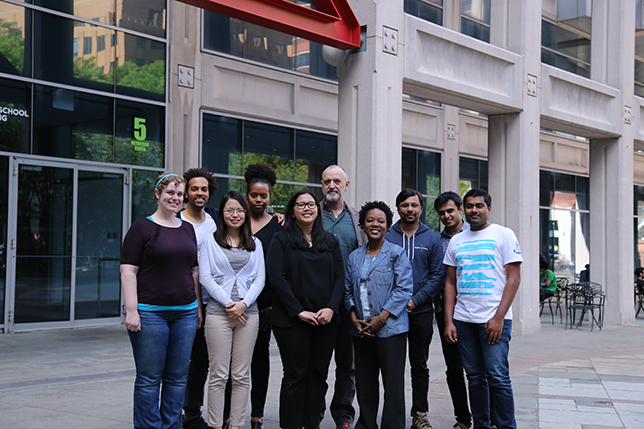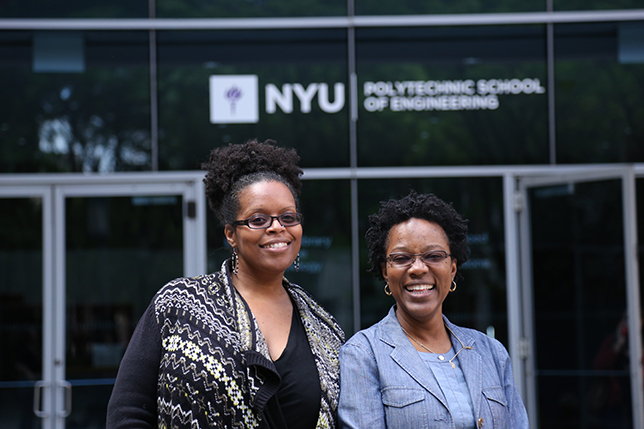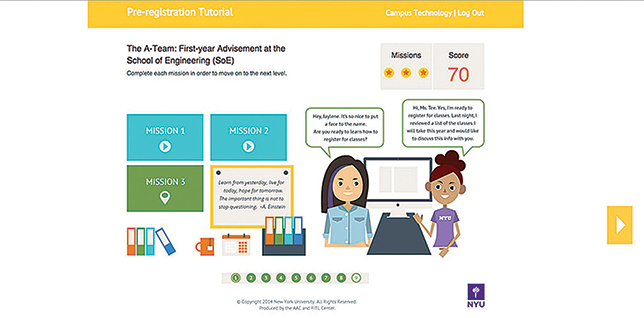A Gamified, Self-Service Approach to Course Registration
Category: Student Systems and Services
Institution: NYU Polytechnic School of Engineering
Project: Pre-registration Tutorial
Project leads: Yona Jean-Pierre, director of faculty innovations in teaching and learning, and Melinda Parham, assistant dean for first-year students & academic initiatives
Tech vendors/partners: Developed in-house

NYU Polytechnic School of Engineering's Faculty Innovations in Teaching and Learning and Academic Advisement teams (photo courtesy of New York University)
A few years ago, the New York University Polytechnic School of Engineering changed its registration process for incoming students. Rather than creating schedules for students and entering them into courses, the school developed a more self-service approach, asking students to take more ownership of the process of understanding course requirements, familiarizing themselves with the curriculum in each academic department and registering themselves.
Initially the engineering school created webinar sessions to help students understand the contextual and technical aspects of the enrollment process. Advisers found that the webinars had limitations, however, including occasional technical difficulties and time zone challenges.
"Given that we are a global university, we wanted to make sure students could access the material at any time," said Yona Jean-Pierre, director of faculty innovations in teaching and learning. "When we were doing it in webinar format, we had specific times we met with students, and not every student could make it to the webinars."
"Because we did not want to add to students' anxiety around enrolling, we went back to the drawing board to see what else we could do," recalled Melinda Parham, assistant dean for first-year students & academic initiatives.

Project leads Melinda Parham (left) and Yona Jean-Pierre (right) (photo courtesy of New York University)
In brainstorming sessions in February 2014, Parham and Jean-Pierre came up with the concept of an online pre-registration tutorial that uses gamification to motivate students to participate and keep them engaged. They also hoped that employing an asynchronous model would enable the students to view the material at their own pace, as many times as needed.
The student logs in and is allowed to go from level to level to complete a series of missions in which they gather information on NYU, the School of Engineering and the first-year registration process. Information is presented through videos, still pictures, interactive apps, PDF documents and links to other university systems.
"We know our students are visual learners. Their lives are extremely digitized. They respond to tools that are put together with this framework in mind," Parham said. "We thought, why not use gamification on a topic that might seem quite boring — learning how to register for classes — and turn it into something that can be exciting or at least pique their interest in a different way?"
The pre-registration tutorial project was the result of a collaborative effort between two support offices: Academic Advisement Center and Faculty Innovations Teaching and Learning Center. The production team, consisting of two application developers, a media producer, an instructional designer, a user interface/interactive designer, one project manager and three content developers, had only 15 weeks to complete the project.
"We needed to have if ready by a specific deadline because we were trying to align with the enrollment calendar with other peers at NYU," Parham explained.
Initially the team looked at a few commercial products and customized solutions to see what peers in other colleges at NYU were doing. "We talked to a few people about the costs, and the costs were ridiculous," Parham said. Jean-Pierre concurred: "The figures floated around far exceeded what we could afford. If we had to come up with those amounts, this project would still be in the works."
Instead, NYU took advantage of talented computer science graduate students taking part in an internship program to help with the project. "It allows graduate students to think about their professional goals in a safe environment," Parham said. "We can present them with ideas and they can help us put them into practice. They are eager to apply what they learned in the classroom to a very specific project."

The Pre-registration Tutorial uses gamification to motivate and engage students through the process of understanding course requirements, curricula and registration.
The pre-registration tutorial launched on June 17, 2014, and was available to more than 600 incoming, first-year students.
Its developers immediately noticed several advantages. When compared to the webinar model, the application generated a higher percentage of students completing the enrollment clearance requirements at a faster pace. "Because that happened, our advisers were able to look at student schedules earlier and make sure they were in correct courses, so all the follow-up work that happens after the enrollment period could be pushed up," Parham said. Also, not having to prepare for and hold the webinars has freed up time for the advising staff to work with students over the summer.
The format also gave them the opportunity to gather data from students more immediately, Jean-Pierre said. In each section, students are given a quiz that confirms that they have absorbed information before going to the next step of the tutorial. Back-end analytics allow Parham's team to see how often students are viewing the tutorial and how long they spend on different segments.
Although the team has not yet surveyed students about the tutorial, many of them have mentioned that it was helpful, Parham said, and some even asked if they could go back to it when the spring enrollment period was approaching.
Parham said she expects to share the app with the larger NYU community. "I am a part of the advising deans committee," she said, "and this is definitely a product they might be interested in using at their schools to revamp the way they bring in their students from an academic advisement standpoint."
Jean-Pierre said that because of the way the application is structured, other schools could easily adapt it. "It can be seen as a shell. Other departments could use the environment, add their content and have it displayed in a similar way. It would require very little customization to do that."
Return to Campus Technology Innovators Awards Home
About the Author
David Raths is a Philadelphia-based freelance writer focused on information technology. He writes regularly for several IT publications, including Healthcare Innovation and Government Technology.